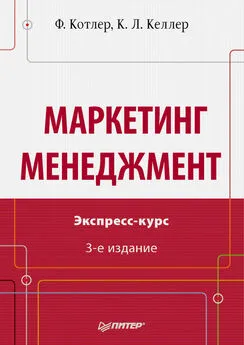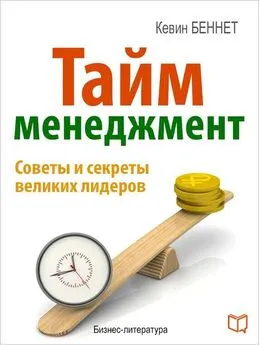Кевин Келлер - Маркетинг менеджмент. Экспресс-курс
- Название:Маркетинг менеджмент. Экспресс-курс
- Автор:
- Жанр:
- Издательство:неизвестно
- Год:неизвестен
- ISBN:нет данных
- Рейтинг:
- Избранное:Добавить в избранное
-
Отзывы:
-
Ваша оценка:
Кевин Келлер - Маркетинг менеджмент. Экспресс-курс краткое содержание
Настоящий «Экспресс-курс» представляет собой сжатое изложение 12-го издания главного труда Ф. Котлера и К. Л. Келлера «Маркетинг менеджмент». Книга сохраняет полноту и содержательность повествования, содержит все основные кейсы, модели и проекты.
Новое, 3-е издание значительно изменено и дополнено. Появился соавтор – один из ведущих мировых специалистов по брендингу, добавлены новые концепции, многие темы получили развитие и отражают современные рыночные реалии, полностью изменены примеры.
Лаконичность текста позволяет рекомендовать эту книгу студентам вузов, изучающим маркетинг, кроме того, она окажет неоценимую помощь тем, кто хочет знать все о маркетинге, но у кого не хватает времени ознакомиться с полным вариантом «Маркетинг менеджмента».
Перевод: И. Малкова
Маркетинг менеджмент. Экспресс-курс - читать онлайн бесплатно ознакомительный отрывок
Интервал:
Закладка:
434
E. Raymond Corey, Industrial Marketing: Cases and Concepts , 4th ed. (Upper Saddle River, NJ: Prentice Hall, 1991), ch. 5.
435
Mike Troy, «From Supply Chain to Demand Chain, A New View of the Marketplace», DSN Retailing Today , October 13, 2003, pp. 8–9.
436
Anne T. Coughlan, Erin Anderson, Louis W. Stern, and Adel I. El-Ansary, Marketing Channels , 6th ed. (Upper Saddle River, NJ: Prentice Hall, 2001), pp. 5–6.
437
Дополнительную информацию о каналах обратного хода вы можете найти в работе: Marianne Jahre, «Household Waste Collection as a Reverse Channel – A Theoretical Perspective», International Journal of Physical Distribution and Logistics 25, no. 2 (1995): 39—55; Terrance L. Pohlen and M. Theodore Farris II, «Reverse Logistics in Plastics Recycling», International Journal of Physical Distribution and Logistics 22, no. 7 (1992): 35—37.
438
Chris Gaither, «Giving PCs the Boot», Boston Globe , April 22, 2003, p. F1.
439
«Ofoto Takes on a New Identity», Chain Drug Review , February 28, 2005, p. 13; Faith Keenan, «Big Yellow’s Digital Dilemma», BusinessWeek, March 24, 2003, pp. 80—81.
440
Louis O. Bucklin, Competition and Evolution in the Distributive Trades (Upper Saddle River, NJ: Prentice Hall, 1972); Stern, et al., Marketing Channels .
441
Louis P. Bucklin, A Theory of Distribution Channel Structure (Berkley: Institute of Business and Economic Research, University of California, 1966).
442
Bridget Finn, «A Quart of Milk, a Dozen Eggs, and a 2.6-GHz Laptop», Business 2.0 , October 2003, p. 58.
443
Edward Helmore, «Media: Why House of Mouse Is Haunted by Failures», The Observer , February 11, 2001, p. 10 (www.disney.com).
444
Дополнительную информацию о маркетинге отношений и управлении маркетинговыми каналами можно найти в работе: Jan B. Geide, «Interorgabizational Governance in Marketing Channels», Journal of Marketing (January 1994): 71—85.
445
Lawrence G. Friedman and Timothy R. Furey, The Channel Advantage: Going To Marketing with Multiple Sales Channels (Woburn, MA: Butterworth-Heinemann, 1999). Данные авторы предлагают оценивать прибыльность канала распределения по отношению затрат к выручке, или коэффициенту E / R . Коэффициент E / R рассчитывается как отношение средних затрат на заключение сделки к среднему размеру заказа. Первый показатель определятся делением общих затрат на использование канала на общее количество сделок. Чем ниже коэффициент E / R , тем прибыльнее канал: на каждый доллар выручки приходится меньше затрат.
446
Erin Killian, «Butter ‘Em Up», Forbes , June 9, 2003, pp. 175—176.
447
Americas.kyocera.com/news/.
448
Erin Anderson and Anne T. Coughlan, «Channel Management: Structure, Governance, and Relationship Management», in Handbook of Marketing , edited by Bart Weitz and Robin Wensley (London: Sage Publications, 2001), pp. 223—247.
449
Bert Rosenbloom, Marketing Channels: A Management View , 5th ed. (Hinsdale, IL: Dryden, 1995).
450
На эту тему есть великолепный доклад: Howard Sutton, Rethinking the Company’s Selling and Distribution Channels, research report no. 885, Conference Board, 1986, p. 26.
451
Russel Johnston and Paul R. Lawrence, «Beyond Vertical Integration – The Rise of the Value-Adding Partnership», Harvard Business Review (July–August 1988): 94–101; Judy A. Siguaw, Penny M. Simpson, and Thomas L. Baker, «Effects of Supplier Market Orientation on Distributor Market Orientation and the Channel Relationship: The Distribution Perspective», Journal of Marketing (July 1998): 99–111; Narakesari Narayandas and Manohar U. Kalwani, «Long-Term Manufacturer-Supplier Relationships: Do They Pay Off for Supplier Firms?» Journal of Marketing (January 1995): 1–16.
452
Anne T. Coughlan and Louis W. Stern, «Marketing Channel Design and Management», in Kellog on Marketing , edited by Dawn Iacobucci (New York: John Wiley, 2001), pp. 247—269.
453
Rob Wheery, «Pedal Pushers», Forbes , October 14, 2002, pp. 205—206.
454
В этом разделе использованы работы: Stern and El-Ansary, Marketing Channels, ch.6; Jonathan D. Hibbard, Nirmalya Kumar and Louis W. Stern, «Examining the Impact of Destructive Acts in Marketing Channel Relationships», Journal of Marketing Research 38 (February 2001): 45—61; Kersi D. Antia and Gary L. Frazier, «The Severity of Contract Enforcement in Interfirm Channel Relationships», Journal of Marketing 65 (October 2001): 67—81; James R. Brown, Chekitan S. Dev and Dong-Jin Lee, «Managing Marketing Channel Opportunism: The Efficiency of Alternative Governance Mechanisms», Journal of Marketing 64 (April 2001), pp. 51—65.
455
Inside 1 -to- 1, Peppers and Rogers Group newsletter, May 14, 2001.
456
Bob Tedeshi, «How Harley Revved Online Sales», Business 2.0 , December 2002/January 2003, p. 44.
457
Pallavi Gogoi, «The Hot News in Banking: Bricks and Mortar», BusinessWeek , April 21, 2003, pp. 83—84.
458
Steve Powers, «Retail: Tricks of the Trader », Business 2.0 , September 2005, p. 36; Amy Wu, «A Specialty Food Store with a Discount Attitude», New York Times , July 27, 2003, pp. 3–4.
459
William R. Davidson, Albert D. Bates, and Stephen J. Bass, «Retail Life Cycle», Harvard Business Review (November–December 1976): 89—96.
460
Stanley C. Hollander, «The Wheel of Retailing», Journal of Marketing (July 1960): 37—42.
461
Amy Merrick, «How Ginhgham and Polyester Rescued a Retailer), Wall Street Journal , May 9, 2003, pp. A1, A6.
462
Kimberley L. Allers, «Retail’s Rebel Yell», Fortune , November 10, 2003, pp. 137—142.
463
Cametta Coleman,»Kohl’s Retail Racetrack», Wall Street Journal , March 1, 2000, pp. B1+.
464
Kenneth T. Rosen and Amanda L. Howard, «E-tail: Gold Rush or Fool’s Gold?» California Management Review (April 1, 2000): 72–100; Moira Cotlier, «Census Releases First E-com-merce Report», Catalog Age , May 1, 2001; Associated Press, «Online Sales Boomed at End of 2000», Star-Tribune of Twin Cities , February 17, 2001; «Reinventing the Store», The Economist , November 22, 2003, pp. 65—68.
465
Более подробное обсуждение этого вопроса приведено в: Philip Kotler, «Atmospherics as a Marketing Tool», Journal of Retailing (Winter 1973—1974): 48—64; Mary Jo Bitner, «Servicescapes: The Impact of Physical Surroundings on Customers and Employees», Journal of Marketing (April 1992): 57—71; B. Joseph Pine II and James H. Gilmore, The Experience Economy (Boston: Harvard Business School Press, 1999).
466
Frank Feather, The Future Consumer (Toronto: Warwick Publishing, 1994), p. 171; Stephen J. Hoch, Xavier Dreeze, and Mary E. Park, «EDPL, Hi-Lo, and Margin Arithmetic», Journal of Marketing (October 1994): 1–15; David R. Bell and James M. Lattin, «Shopping Behavior and Consumer Preference for Retail Price Format», Marketing Science 17 (Spring 1998): 66—68.
467
R. L. Davies and D. S. Rogers, eds., Store Location and Store Assessment Research (New York: John Wiley, 1984).
468
Sara L. McLafferty, Location Strategies for Retail and Service Firms (Lexington, MA: Lexington Books, 1987).
469
Theresa Howard, «Retail Stores Pop Up for Limited Time Only», USA Today , May 28, 2004, p. 1B.
470
Wendy Liebmann, «Consumers Push Back», Brandweek , February 23, 2004, pp. 19—20.
471
Wendy Liebmann, «Consumers Push Back», Brandweek , February 23, 2004, pp. 19—20.
472
Более подробное обсуждение тенденций розничной торговли приведено в работе: Anne T. Coughlan, Erin Anderson, Louis W. Stern, and Adel I. El-Ansary, Marketing Channels , 6th ed. (Upper Saddle River, NJ: Prentice Hall, 2001).
473
Shelley Donald Coolidge, Facing Saturated Home Markets, Retailers Look to Rest of World», Christian Science Monitor , February 14, 1994, p. 7; Carla Rapoport with Justin Martin, «Retailers Go Global», Fortune , February 20, 1995, p. 102—108; Amy Feldman, «Wal-Mart: How Big Can It Get?» Money , December 1999, pp. 158—164; Kerry Capell and Heidi Dawley, «Wal-Mart’s Not-So-Secret British Weapon», BusinessWeek , January 24, 2000, p. 132.
474
James A. Narus and James C. Anderson, «Contributing as a Distributor to Partnerships with Manufacturers», Business Horizons (September–October 1987); James D. Hlavecek and Tommy J. McCuistion, «Industrial Distributors – When, Who, and How», Harvard Business Review (March–April 1983): 96–101.
475
Bert McCammon, Robert F. Lusch, Deborah S. Coykendall, and James M. Kenderline, Wholesaling in Transition ( Norman: University of Oklahoma, College of Business Administration, 1989).
476
Kate Maddox, Sean Callahan, and Carol Krol, «Top Trends», B to B , June 13, 2005, pp. 22+; «Annual Meetings: Grainger Out to Build Distribution Efficiency», Crain’s Chicago Business , May 6, 2002, p. 12.
477
Narus and Anderson, «Contributing as a Distributor to Partnerships with Manufacturers»; James D. Hlavecek and Tommy J. McCuistion, «Industrial Distributors – When, Who, and How».
478
Ronald Henkoff, «Delivering the Goods», Fortune, November 28, 1994, pp. 64—78.
479
Ronald Henkoff, «Delivering the Goods», Fortune, November 28, 1994, pp. 64—78.
480
Rita Koselka, «Distribution Revolution», Forbes , May 25, 1992, pp. 54—62.
481
Оптимальный объем заказа определяется по формуле Q = 2 DS / C , где D – годовой объем спроса; S – затраты на размещение одного заказа; C – стоимость годового хранения единицы товара. Здесь предполагается, что затраты на обработку заказа постоянны, затраты на хранение дополнительной единицы товара тоже постоянны, спрос известен заранее и нет оптовых скидок.
482
William C. Copacino, Supply Chain Management (Boca Raton, FL: St. Lucie Press, 1997) pp. 122—123.
483
Намек на систему маркировки размеров одежды: XXL – самый большой, S – самый маленький.
Читать дальшеИнтервал:
Закладка:










